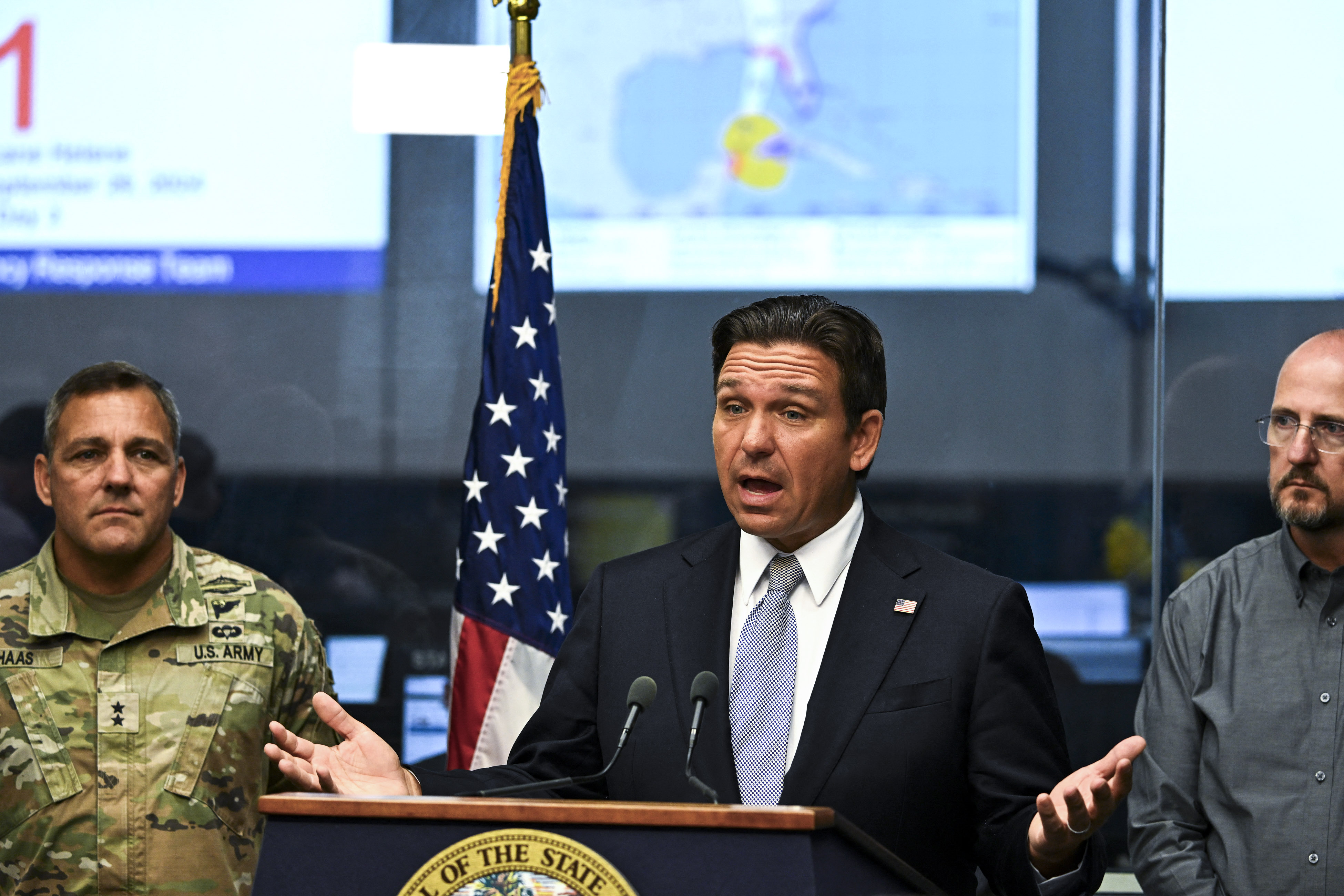


TAMPA, Fla.—After more than a week of watching, worrying, and speculating, Floridians came face to face with Hurricane Milton.
There was damage in Milton’s wake, as well as tragedies. At least 10 people lost their lives because of the storm.
For most, however, it was a hurricane that wasn’t as bad as expected.

Secretary of Homeland Security Alejandro Mayorkas confirmed on Oct. 10 that the Federal Emergency Management Agency (FEMA) will need more funding as soon as possible following hurricanes Milton and Helene.
Helene dealt widespread damage across the southern United States, doing its worst in western North Carolina, after making landfall late last month. Milton slammed into Florida’s Gulf Coast as a category 3 hurricane late on Oct. 9, and officials have not fully surveyed the extent of the damage.
In a news conference at the White House, Mayorkas said he believed FEMA has enough funding to deal with the aftermath of both storms, when answering questions from reporters.





President Joe Biden called on Congress to return for a special session to allocate funding for relief efforts following the hurricanes.

“Congress should be coming back and moving on emergency needs immediately. They're going to have to come back after the election as well. This is going to be a long haul for total rebuilding,” he said.

VENICE, Fla.—After hours of howling winds, battering rain, and stress-filled uncertainty, Venice residents awoke on Thursday to clear skies and scattered debris. Hurricane Milton took a sharp turn to the east the night before, making landfall near Siesta Key around 8:30 p.m. just hours after the National Hurricane Center predicted a landfall just south of Tampa Bay.

Some estimates indicated Venice could get between 10 and 15 feet of storm surge once the back of Milton’s eye came ashore. As the center of the massive eye engulfed areas between Lakewood Ranch and Venice at roughly 9 p.m. Wednesday, screaming wind gusts were replaced with an eerie and surreal calmness, as winds diminished to a gentle breeze. That break was short-lived, as the back of the storm’s eye—which carries the brunt of the hurricane’s surge—made its way on shore.






The hurricane roared onshore near the Sarasota area on Wednesday night as a Category 3 storm, according to the National Hurricane Center (NHC), bringing winds in excess of 110 mph.
Officials with the Rays said that a handful of “essential personnel” were inside Tropicana Field, located in St. Petersburg as the storm hit. Footage showed the swaths that serve as the domed building’s roof were completely tattered, giving a clear line of sight inside the stadium.

The director of the Federal Emergency Management Agency (FEMA) said Florida appeared to have dodged a “worst-case scenario” during Hurricane Milton, which made landfall on Wednesday night as a Category 3 storm before passing over the state.
Milton, which formed in the southwestern Gulf of Mexico, strengthened to a Category 5 hurricane with 185 mph winds several days before it slammed into Florida’s Gulf Coast about 50 miles south of Tampa. But as the storm neared Florida, the National Hurricane Center (NHC) downgraded the system to a Category 3.
“What we know for sure is we avoided that worst-case scenario that we were planning for,” FEMA Director Deanne Criswell told CNN on Thursday morning. “But the fact that they prepared for the worst really made sure that they were able to respond to the impacts that they have experienced, and the biggest ones right now are the tornadoes that have been reported across the state.”




TAMPA—The sun returned to the skies above Tampa the morning after Hurricane Milton cut through, revealing to many returning residents that the piles of uncollected debris had barely moved.
Hurricane-force winds descended upon the Tampa Bay region Wednesday night. In St. Petersburg, they tore the roof off of Tropicana Field, and brought a giant construction crane crashing down.





Multiple deaths have been reported in Florida from tornadoes, spawned by Hurricane Milton, that ripped through the state, downing buildings and trees and leaving millions without power.
The St. Lucie County Sheriff’s Office confirmed four people in the county were killed after numerous tornadoes struck the area in quick succession, wreaking devastation.











Florida Gov. Ron DeSantis on Wednesday responded to claims on social media suggesting that federal officials will not allow residents back in their homes after Hurricane Milton, which is now a Category 1 storm and is expected to move east over the Atlantic Ocean later Thursday.
The governor denied those claims, saying that his administration is in charge of the hurricane response, not the Federal Emergency Management Agency (FEMA). It’s not clear where those rumors originated.
“We live in an era where if you put out crap online, you can get a lot of people to share it and you can monetize that. That’s just the way it is,” DeSantis told the news conference, adding that “in the state of Florida none of that stuff would ever fly.”


Officials in Florida have warned of the fire danger posed by electric vehicles (EVs) that are inundated by floodwaters as Hurricane Milton began its assault on the Sunshine State on Oct. 9.
“You can put your electric vehicles up high,” Castor said in the press conference. “Make sure you are elevating all those electric batteries and electric items as well because those batteries—once they start on fire—they cannot be extinguished.”



TAMPA, Fla.—Millions of displaced evacuees are bunkered inland. And more than 50,000 electrical linemen; 34 search-and-rescue teams; and thousands of National Guard soldiers, law enforcement officers, and first responders from more than 20 states are entrenched, poised to face a monster unlike any seen in Florida for decades.
As of mid-afternoon Oct. 9, the outer bands of Hurricane Milton were battering central Florida with increasingly heavy rains and thunderstorms sprouting strings of tornado alerts, the opening salvos of what will be a long night’s journey to a day that dawns on a violently reshaped landscape.
Milton at 7 p.m. was a category 3 hurricane with maximum sustained wind speeds of 120 miles per hour. The National Hurricane Center (NHC) expected Milton to make landfall as an “extremely dangerous major hurricane” sometime between 10 p.m. and midnight somewhere in southern Sarasota County, about 40 miles south of Tampa Bay.










Hurricane Milton is projected to make landfall in the Tampa area late Wednesday, in what Tampa Mayor Jane Castor said will be the “storm of the century.”
Milton is expected to bring violent storm surges with flooding as high as 15 feet in some areas.

U.S. Federal Emergency Management Agency (FEMA) Administrator Deanne Criswell responded to a question during a Wednesday White House press briefing about online misinformation pertaining to the agency’s hurricane response efforts.
She said some people in the areas affected by Hurricane Helene are afraid to approach FEMA’s staff to ask for assistance “because they are unsure of what the government is doing.”






Florida’s chief financial officer warned that Hurricane Milton could cause damage totaling as much as $20 billion in the state as the Category 4 storm continues to churn toward the Florida Gulf Coast.
Milton is forecast to strike near the Tampa Bay area late on Oct. 9 or early on Oct. 10, according to forecast models from the National Hurricane Center. While it has weakened from a Category 5, officials say the storm is expected to hit the state as a major hurricane, meaning a Category 3 or greater.
Jimmy Patronis, the state’s chief financial officer and fire marshal, told Fox Business that the expected damage depends on the exact location of where the storm makes landfall.










Officials in Florida issued stark warnings to would-be looters during Hurricane Milton that they could get shot or arrested.
“Florida will not stand for looting—we will not stand for it. We will come after you,” Mark Glass, commissioner of the Florida Department of Law Enforcement, told reporters on Wednesday morning.






Researchers with the USGS noted that 95 percent of Florida’s western coast sandy beaches are going to be “continuously covered by ocean water” as Milton slams into the state later Wednesday.
“This is the most severe level of coastal change,” the agency warned on Monday.


Floridians were scurrying on Oct. 8 to prepare for a second devastating hit in as many weeks. But this time they expected a storm unlike any the hurricane-hardened residents in the central swath of the state have seen in 20 years.
With Hurricane Milton barreling toward a projected Tampa Bay-area landfall—the first in a century—residents in coastal evacuation zones still inundated by Hurricane Helene’s sideswipe were being urged to flee.
But the main escape routes, Interstate 75–running from the bottom of the state to the top and beyond–and Interstate 4, which stretches across the state, intermittently left drivers at a standstill for miles.






